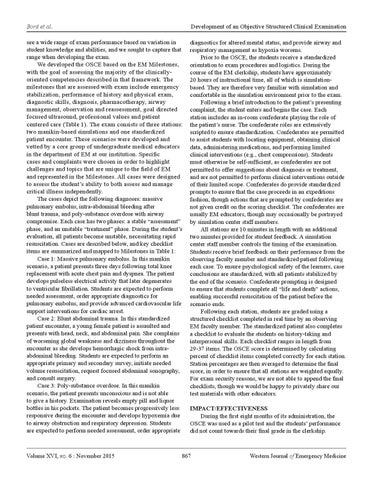Bord et al.
Development of an Objective Structured Clinical Examination
see a wide range of exam performance based on variation in student knowledge and abilities, and we sought to capture that range when developing the exam. We developed the OSCE based on the EM Milestones, with the goal of assessing the majority of the clinicallyoriented competencies described in that framework. The milestones that are assessed with exam include emergency stabilization, performance of history and physical exam, diagnostic skills, diagnosis, pharmacotherapy, airway management, observation and reassessment, goal directed focused ultrasound, professional values and patient centered care (Table 1). The exam consists of three stations: two manikin-based simulations and one standardized patient encounter. These scenarios were developed and vetted by a core group of undergraduate medical educators in the department of EM at our institution. Specific cases and complaints were chosen in order to highlight challenges and topics that are unique to the field of EM and represented in the Milestones. All cases were designed to assess the student’s ability to both assess and manage critical illness independently. The cases depict the following diagnoses: massive pulmonary embolus, intra-abdominal bleeding after blunt trauma, and poly-substance overdose with airway compromise. Each case has two phases: a stable “assessment” phase, and an unstable “treatment” phase. During the student’s evaluation, all patients become unstable, necessitating rapid resuscitation. Cases are described below, and key checklist items are summarized and mapped to Milestones in Table 1: Case 1: Massive pulmonary embolus. In this manikin scenario, a patient presents three days following total knee replacement with acute chest pain and dyspnea. The patient develops pulseless electrical activity that later degenerates to ventricular fibrillation. Students are expected to perform needed assessment, order appropriate diagnostics for pulmonary embolus, and provide advanced cardiovascular life support interventions for cardiac arrest. Case 2: Blunt abdominal trauma. In this standardized patient encounter, a young female patient is assaulted and presents with head, neck, and abdominal pain. She complains of worsening global weakness and dizziness throughout the encounter as she develops hemorrhagic shock from intraabdominal bleeding. Students are expected to perform an appropriate primary and secondary survey, initiate needed volume resuscitation, request focused abdominal sonography, and consult surgery. Case 3: Poly-substance overdose. In this manikin scenario, the patient presents unconscious and is not able to give a history. Examination reveals empty pill and liquor bottles in his pockets. The patient becomes progressively less responsive during the encounter and develops hypoxemia due to airway obstruction and respiratory depression. Students are expected to perform needed assessment, order appropriate
diagnostics for altered mental status, and provide airway and respiratory management as hypoxia worsens. Prior to the OSCE, the students receive a standardized orientation to exam procedures and logistics. During the course of the EM clerkship, students have approximately 20 hours of instructional time, all of which is simulationbased. They are therefore very familiar with simulation and comfortable in the simulation environment prior to the exam. Following a brief introduction to the patient’s presenting complaint, the student enters and begins the case. Each station includes an in-room confederate playing the role of the patient’s nurse. The confederate roles are extensively scripted to ensure standardization. Confederates are permitted to assist students with locating equipment, obtaining clinical data, administering medications, and performing limited clinical interventions (e.g., chest compressions). Students must otherwise be self-sufficient, as confederates are not permitted to offer suggestions about diagnosis or treatment, and are not permitted to perform clinical interventions outside of their limited scope. Confederates do provide standardized prompts to ensure that the case proceeds in an expeditious fashion, though actions that are prompted by confederates are not given credit on the scoring checklist. The confederates are usually EM educators, though may occasionally be portrayed by simulation center staff members. All stations are 10 minutes in length with an additional two minutes provided for student feedback. A simulation center staff member controls the timing of the examination. Students receive brief feedback on their performance from the observing faculty member and standardized patient following each case. To ensure psychological safety of the learners, case conclusions are standardized, with all patients stabilized by the end of the scenario. Confederate prompting is designed to ensure that students complete all “life and death” actions, enabling successful resuscitation of the patient before the scenario ends. Following each station, students are graded using a structured checklist completed in real time by an observing EM faculty member. The standardized patient also completes a checklist to evaluate the students on history-taking and interpersonal skills. Each checklist ranges in length from 29-37 items. The OSCE score is determined by calculating percent of checklist items completed correctly for each station. Station percentages are then averaged to determine the final score, in order to ensure that all stations are weighted equally. For exam security reasons, we are not able to append the final checklists, though we would be happy to privately share our test materials with other educators.
Volume XVI, no. 6 : November 2015
IMPACT/EFFECTIVENESS During the first eight months of its administration, the OSCE was used as a pilot test and the students’ performance did not count towards their final grade in the clerkship.
867
Western Journal of Emergency Medicine
